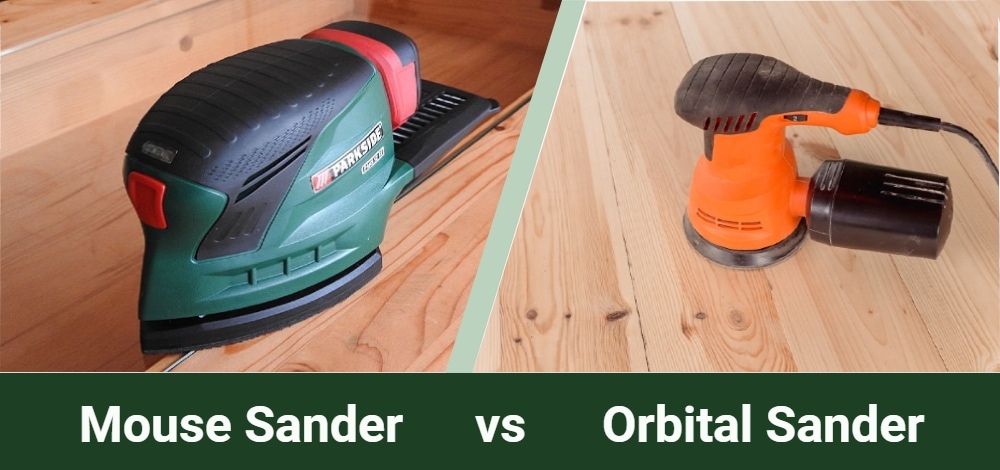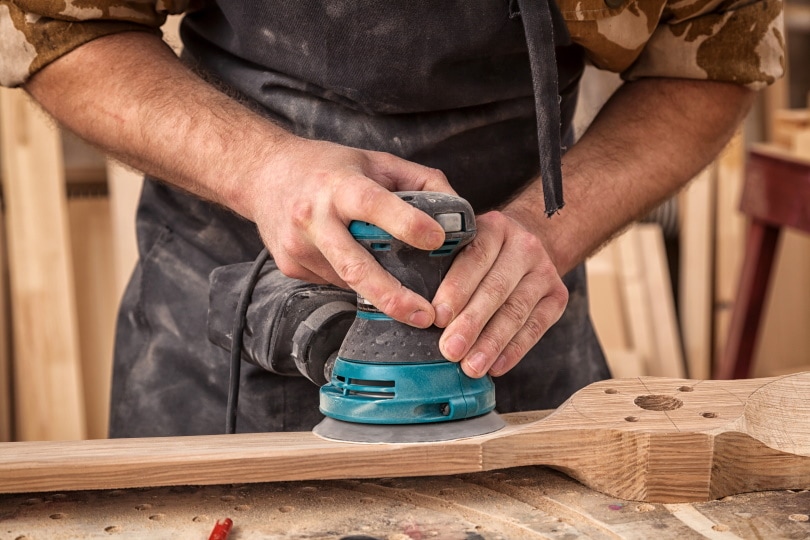Mouse vs Orbital Sander: Pros, Cons, & Differences
-
Visnja Radosavljevic
- Last updated:

If you are into woodworking or DIY, you’re probably sanding fairly frequently. Power sanders can make the sanding process much easier and faster than using sandpaper, which is why many people love these tools. However, with so many available sanders, it can be tricky to know which one you should use, especially if you’re a beginner.
Some of the most frequently used sanders are the mouse sander and orbital sander. While they look similar, they have different functions, which we’ll describe in the article.
Keep reading to learn more about these tools, how they operate, and which sander you need for a specific project.
Overview of Mouse Sanders
A mouse sander, also known as the detail sander, is a hand-held tool that is small, pointy, and slim on one end while it’s rounded on the other. Mouse sanders are versatile and user–friendly, allowing you to sand small areas and corners you’d typically have difficulties reaching by operating in a back-and-forth motion. It’s also an excellent tool when sanding surfaces with curves.
Commonly, mouse sanders provide a soft grip, so you can easily control the sander. These sanders are lightweight, and their design allows you to use them for an extended period without hurting your hands. While mouse sanders can vary in design, it’s not uncommon for a mouse sander to have additional attachments like:
- A detail finger attachment: It increases the versatility of the mouse sander because it allows you to reach even the most minor, hard-to-reach areas. It’s shaped like a long finger, and it’s hooked at the top of the sander.
- Contour attachment: It allows you to sand curved surfaces.
- Dust trap collection system: It collects the sawdust that appears during the sanding process. This addition is highly beneficial because it makes the job easier and less messy.
Most mouse sanders can use different sandpaper grits, from fine to coarse. They have a hook and loop system where the back of the sandpaper is lined with fabric, and it sticks to loops located at the base of the sander.
When To Use a Mouse Sander?
You can use a mouse sander when polishing small surfaces, like wood floors, cabinets, and windows. Mouse sanders are a great tool when refinishing old furniture, working on minor details, and reaching into tight spaces. Because of their size, they’re not the best for larger tasks, as they would be time-consuming.
Try to use mouse sanders for minor repairs and when you need to sand spots that seem out of reach.
- Versatile
- User-friendly
- Precise in tiny spaces
- Efficient
- Works with various attachments
- Not the best choice for larger tasks
Overview of Orbital Sanders
Orbital sanders are standard tools people use for various sanding projects. They are hand-held tools that use rapid, circular vibrations to sand. When you attach the sandpaper (typically square-shaped) to an orbital sander, you can efficiently smooth out wood, metal, and plastic.
While working, the orbital sander spins while moving in a circular motion, causing the sandpaper to make circular movements. Because of that, there are fewer swirl marks on the surface you’re sanding, while the sanding process is more efficient.

However, you need to remember to apply even pressure when using an orbital sander; otherwise, you risk sanding more from one side of the surface but less from the other. Additionally, you can use some orbital sanders for polishing if they have attachments and a variable speed.
Orbital sanders can use sandpaper of all grits, from coarse to fine, and the sandpaper you need will depend on your current project. Similar to mouse sanders, orbital sanders also have a dust collection system that makes the sanding process easier.
When To Use an Orbital Sander?
Orbital sanders are excellent for removing paint and stains, removing imperfections on various materials, and scraping up furniture before painting. They are handier than mouse sanders when working on large areas, and you can also use them to sand drywall joints and wood fillers.
- Handy
- Versatile
- Provides a smooth finish
- Efficient
- Excellent for removing stains and paint
- Can’t remove thick paint layers
Mouse Sander vs Orbital Sander – Main Differences
While mouse sanders and orbital sanders are both hand-held sanding tools, they have different functions, meaning you need to select the proper sander for your project. Below are some of the main differences between mouse sanders and orbital sanders.
Function
Both mouse sanders and orbital sanders are efficient, but they have different functions. Here’s a chart showing which sander works for which type of project.
- Refinishing wooden furniture
- Reaching into small areas and surfaces
- Finishing windows, cabinets, and doors
- When working on minor details
- Removing paint and stains from wood
- For a fine finish on large wood, plastic, or metal surfaces
- Preparing surfaces for painting/sealing
- Refinishing wood furniture
While the orbital sander has square-like sandpaper but rotates in circles, the mouse sander has a triangular-shaped sanding base. Due to their shape, mouse sanders are great for minor details and reaching small areas, while orbital sanders are a better choice for larger surfaces.
For light tasks, mouse sanders are a better option, but if there’s a larger scale task in front of you, you should choose an orbital sander.

Sandpaper
When it comes to the sandpaper you can use on the mouse and orbital sanders, there are no major differences. Both types of sanders can use all sandpapers, from extra fine to coarse. It all comes down to the type of project you’re doing, which will dictate the sandpaper you need to use.
Price
Mouse sanders are commonly more affordable than orbital sanders. Although they’re versatile, they are less versatile than orbital sanders, which is why they have a lower price.
When it comes to orbital sanders, their price varies depending on the type of the sander.
You can find two types of orbital sanders:
- Cordless
- Corded
Cordless models are usually pricier than corded models, as there’s no need for an outlet. However, sometimes it’s better to choose a corded type if you don’t want to worry about the runtime of your projects. While cordless orbital sanders can operate for 30 minutes up to an hour, corded orbital sanders can run for as long as you’d like.
What Type of Sander Do You Need?
When choosing between a mouse and an orbital sander for a particular project, first determine the scale of the task in front of you.
If you need a fast solution for a larger area, the orbital sander should be your top pick. However, if you’re looking for a sander for a smaller task in a minor area, you should go for the mouse sander.
- Refinishing furniture
- Finishing cabinets, doors, or windows
- Crafting projects
- Sanding small, unreachable areas
- Preparing surfaces for sealing or painting
- Refinishing hardwood floors
- Removing paint from wood surfaces
- Refinishing wood furniture
Once you know all the things you need to do for your project, it will be much easier to determine which of these two sanders you need to use. If you get an opportunity, try working with both of these sanders, as that will give you a better overview of how they function and how the finished project will look.
Final Thoughts
Both the mouse sander and orbital sander are practical, versatile, and handy. While both tools sand, they have different functions, so their usage will vary from project to project. If you typically do bigger tasks where you need to cover large surfaces, you won’t go wrong by choosing an orbital sander. On the other hand, if you enjoy doing minor projects on smaller surfaces, the mouse sander will become your best sidekick.
- “What is a Mouse Sander?”
- “Orbital sander vs mouse sander (orbital sander vs detail sander)- what sander should you buy?”
- “WHAT IS AN ORBITAL SANDER?”
- “The Ultimate Guide To Orbital Sanders”
- “How Does An Orbital Sander Work And The Right Time To Use It”
- “Orbital Sander vs Mouse Sander (Which One Is Best)”
- “Mouse Sander vs Orbital Sander: How To Choose The Right One For a Task”
- “What type of sander do I need for which job?”
- “THE BEST SANDERS FOR WOOD AND WHEN TO USE THEM”
Featured Image Credit: (L) PxHere | (R) evgengerasimovich, Shutterstock
Contents
